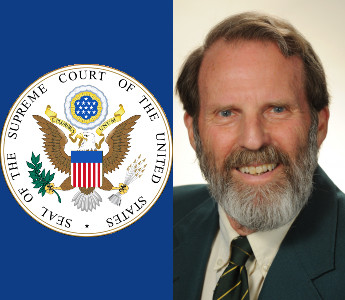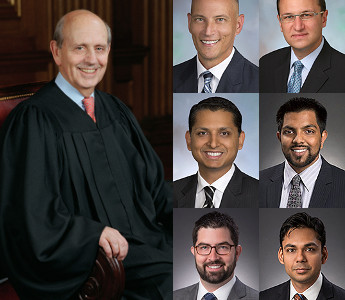United States Army Corps of Engineers v. Hawkes Co., Inc., 578 U.S. ___ (2016) (Roberts, C.J.). Response by Professor Robert L. Glicksman
Geo. Wash. L. Rev. On the Docket (Oct. Term 2015)
Slip Opinion | Politico | SCOTUSblog
Navigating the Clean Water Act
The Supreme Court held in United States Army Corps of Engineers v. Hawkes Co.1 that a determination by the United States Army Corps of Engineers (“Corps”) that the owners of land used for peat mining were obliged to apply to the Corps for a permit under the Clean Water Act (“CWA”)2 before dredging or filling the land was a judicially reviewable final agency action. Although this conclusion seems unremarkable, the case potentially packs a more significant punch from the perspective of administrative and, especially, environmental law. Some background on the history of the Court’s involvement with the relevant CWA permit program program helps to understand why.
The Supreme Court has had a contentious relationship with the CWA, and in particular with its dredge and fill (or section 404) permit program since the dawn of the 21st century. The section 404 program prohibits the dredging or filling of “navigable waters” without a permit issued under a program jointly administered by the U.S. Environmental Protection Agency (“EPA”) and the Corps of Engineers.3 Under Corps regulations, issuance of a permit depends on factors that include the availability of project sites that would not require the dredging or filling of covered navigable waters, as well as the applicant’s ability to minimize harm to such waters if avoidance is not possible and to mitigate any harms that do occur.4 The Court’s repeated encounters with the section 404 program have had nothing to do with the criteria for permit issuance or denial, however. Rather, they have implicated the Corps’s and EPA’s interpretations of the jurisdictional scope of the program and the availability of judicial review of the two agencies’ administration of the program.
The CWA defines “navigable waters” as “waters of the United States.”5 For decades, EPA and the Corps have interpreted that term, which the statute does not further define, to include certain types of wetlands. In 1985, the Supreme Court afforded Chevron deference6 to a Corps regulation defining waters of the United States to include wetlands adjacent to traditional navigable waters.7 In 2001, however, based partly on federalism concerns, the Court held in Solid Waste Agency of North Cook County v. United States Army Corps of Engineers (“SWANCC”)8 that the Corps acted beyond the scope of its authority in applying the section 404 program to discharges to an abandoned sand and gravel pit that the Corps sought to regulate because it was used as habitat for migratory birds.9 Five years later, a plurality of a splintered Court ruled in Rapanos v. United States10 that wetlands connected to traditional navigable waters by a series of man-made ditches and natural tributaries did not qualify as waters of the United States.11 Concurring in Rapanos, Justice Kennedy, in an opinion joined by no other Justice, interpreted the CWA as covering only those wetlands that possess a “significant nexus” to traditional navigable waters.12 In a separate concurrence,13 Chief Justice Roberts bemoaned the absence of a majority opinion and the resulting need for lower courts and regulated entities to “have to feel their way on a case-by-case basis,” and seemed to urge the Corps to clarify its regulations.14 The Corps and EPA sought to do just that in 2015 by overhauling their joint regulatory definitions of terms key to ascertaining the scope of the section 404 program.15 Those regulations are the subject of a host of pending lawsuits challenging their substantive validity.
Another line of cases raised issues concerning the availability of judicial review to challenge the two agencies’ implementation of the section 404 program. In Sackett v. EPA,16 decided in 2012, the Court held that an administrative compliance order issued by the EPA to redress private property owners’ failure to secure a section 404 permit before filling in wetlands on their property with dirt was a final agency action immediately reviewable in federal court under the Administrative Procedure Act (“APA”)17 even though the EPA had not yet initiated an action, administrative or judicial, to enforce the compliance order.18 The litigants were thus entitled to challenge the EPA’s determination that their property included jurisdictional wetlands—the navigable waters issue—even before the commencement of such an enforcement action. According to at least one Justice, the case left open questions such as whether pre-enforcement review is also available of the substantive terms of a compliance order.19
These two lines of cases converged in this term’s decision in United States Army Corps of Engineers v. Hawkes Co. Three companies engaged in peat mining in Minnesota applied to the Corps for a section 404 permit. The Corps issued an “approved jurisdictional determination” (“JD”), finding that the companies’ property had a significant nexus to the Red River of the North, located about 120 miles away. When the companies sought judicial review of this JD, the district court dismissed for lack of subject matter jurisdiction, finding the absence of reviewable final agency action.20 The Eighth Circuit reversed, relying heavily on Sackett.21 The Supreme Court affirmed.22
The Court’s treatment of the justiciability issue is mostly unremarkable. All eight sitting justices agreed that the JD was a final agency action for purposes of the APA’s judicial review provisions, although they did so in four opinions: Chief Justice Roberts’s majority opinion, joined by six other justices, and concurring opinions by Justice Kennedy (joined by Justices Thomas and Alito),23 Justice Kagan,24 and Justice Ginsburg (the only Justice not to join the majority opinion).25 The Court analyzed the case under the two-part framework for assessing finality enunciated in Bennett v. Spear,26 a 1997 decision. The government did not dispute that the JD met the first prong of the Bennett test—the JD marked the consummation of the Corps’s decision making process. The Court held that the JD also satisfied the second Bennett factor because it had “direct and appreciable legal consequences.”27 Among other things, a JD like the one at issue in Hawkes denies property owners the “safe harbor” that a negative determination, which commits the government not to take enforcement action for five years, would have provided under a Memorandum of Agreement between EPA and the Corps. Further, a JD “warns that if [property owners] discharge pollutants onto their property without obtaining a permit from the Corps, they do so at the risk of significant criminal and civil penalties.”28 The Court noted that its conclusion tracked the “pragmatic” approach it had long taken to finality.29
The holding in Hawkes likely surprised few, given the case’s similarity to Sackett. The fact that the Corps itself had described JDs as “final agency action” in its regulations30 would have made a contrary result hard to fathom. One interesting aspect of the decision is its application of a provision in section 704 of the APA on which the Court has provided relatively slim guidance. Section 704 provides that final agency action “for which there is no other adequate remedy in a court” is subject to judicial review.31 The Court in Hawkes ruled that requiring the mining companies to discharge the fill material without a permit, await an enforcement action, and challenge the Corps’s jurisdiction at that time, is not an adequate alternative to immediate review of a JD because that course of action runs the risk of triggering serious civil and criminal penalties. Nor would it be an adequate alternative to apply for a permit and then seek judicial review of an unanticipated denial on the ground that the relevant discharge is not to navigable waters so that a permit was not required after all, in light of the “arduous, expensive, and long” nature of the permit process.32
Another aspect of the case that will be interesting to follow in future decisions relates to the status of the Bennett test for finality. In her concurring opinion, Justice Ginsburg appeared to give Bennett short precedential shrift, claiming that it “dealt with finality quickly, and did not cite [prior] pathmarking decisions” such as the iconic Abbott Laboratories v. Gardner.33 She stated clearly that Bennett “does not displace or alter the approach to finality established” in those earlier cases.34 To the extent those cases implicate additional factors, or weigh the factors differently, the choice of the precedents to apply in resolving finality issues can matter.
The decision in Hawkes may prove to be more significant in the clues it provides about the ultimate fate of the litigation attacking the implementing agencies’ regulations revisiting the navigable waters issue. The majority opinion’s background description of the case, quoting Rapanos, refers, apparently with some concern, to the scope of the program, which covers “270-to-300 million acres of swampy lands in the United States—including half of Alaska and an area the size of California in the lower 48 States.”35 The reference to “swampy” lands is evocative of an earlier era when what we now call wetlands were often regarded as useless, if not harmful swamps or bogs. The opinion also refers to the “significant” costs of obtaining a permit, recounting a study that found an average of 788 days and more than a quarter million dollars spent in completing the permit process.36 Justice Kennedy’s negative reaction to the statute is even more transparent, referring to “the Act’s ominous reach.”37 Neither opinion quoted the most inflammatory and disparaging rhetoric used in Justice Scalia’s plurality opinion in Rapanos: the Corps “exercises the discretion of an enlightened despot”; the CWA is a “prosaic, indeed downright tedious statute”; Congress, in enacting the CWA, was “unwilling[] to confront the environmental lobby.”38
Three members of the Court may be willing to move beyond rhetoric in reining in the CWA’s scope. In language sure to trigger applause or acute fear in different constituencies, Justice Kennedy’s concurrence, joined by Justices Thomas and Alito, remarks that the Corps’s JDs “in many instances will have a significant bearing on whether the Clean Water Act comports with due process.”39 It is unclear from this cryptic reference exactly what the nature of the due process problem might be, although one can speculate based on questions he asked at oral argument that Justice Kennedy is concerned about the lack of notice to those owning property that includes wetlands as to whether or not those wetlands trigger section 404 permitting requirements. If the lack of clarity is the chief concern, the Court itself surely bears some of the blame, especially after the welter of irreconcilable and non-dispositive opinions it served up in Rapanos. Justice Kennedy’s concern may sweep more broadly, however. In what could be construed as raising a broad substantive due process concern, he asserted that the CWA “continues to raise troubling questions regarding the Government’s power to cast doubt on the full use and enjoyment of private property throughout the Nation.”40
Is the CWA at risk of being declared unconstitutional?41 Litigants asked the Court to invalidate the dredge and fill permit program’s application in both SWANCC and Rapanos, but the Court in both cases found it unnecessary to decide the constitutional federalism questions raised. Instead, it invoked the constitutional avoidance doctrine and interpreted the statute narrowly in concluding that the Corps had exceeded the scope of its authority in regulating the waters and wetlands at issue. The identity of the next Justice is certainly relevant to any assessment of the viability of another constitutional attack on the section 404 program. It is possible, though, that the Court will follow the same constitutional avoidance path on the basis of the due process challenge that Justice Kennedy’s opinion invites when, as seems inevitable, the Court is called on to address the validity of the 2015 joint EPA-Corps regulations.
- U.S. Army Corps of Eng’rs v. Hawkes Co., No. 15–290, slip op. (U.S. May 31, 2016).
- 33 U.S.C. §§ 1251–1387 (2012).
- Id. §§ 1311(a), 1344(a).
- 33 C.F.R. § 320.4 (2015) (Corps regulations); 40 C.F.R. § 230.10 (2015) (EPA regulations).
- 33 U.S.C. § 1362(7) (2012).
- Chevron U.S.A. Inc. v. Natural Res. Def. Council, Inc., 467 U.S. 837 (1984).
- United States v. Riverside Bayview Homes, Inc., 474 U.S. 121 (1985).
- Solid Waste Agency of N. Cook Cty. v. U.S. Army Corps of Eng’rs, 531 U.S. 159 (2001).
- Id. at 174.
- Rapanos v. United States, 547 U.S. 715 (2006).
- Id. at 757.
- Id. at 759 (Kennedy, J., concurring).
- Id. at 757. (Roberts, C.J., concurring).
- Id. at 758.
- 80 Fed. Reg. 37,054 (June 29, 2015).
- Sackett v. EPA, 132 S. Ct. 1367 (2012).
- Administrative Procedure Act, Pub. L. No. 79-404, 60 Stat. 237 (codified as amended in scattered sections of 5 U.S.C.).
- Sackett, 132 S. Ct. at 1369.
- Id. at 1374–75 (Ginsburg, J, concurring).
- Hawkes Co. v. U.S. Army Corps of Eng’rs, 963 F. Supp. 2d 868, 878 (D. Minn. 2013).
- Hawkes Co. v. U.S. Army Corps of Eng’rs, 782 F.3d 994, 1002 (8th Cir. 2015).
- U.S. Army Corps of Eng’rs v. Hawkes Co., No. 15–290, slip op. at 10 (U.S. May 31, 2016).
- Hawkes, slip op. at 1 (Kennedy, J., concurring).
- Hawkes, slip op. at 1 (Kagan, J., concurring).
- Hawkes, slip op. at 1 (Ginsburg, J., concurring in part and concurring in the judgment).
- Bennett v. Spear, 520 U.S. 154 (1997).
- Hawkes, slip op. at 6. The Court found it unnecessary to decide whether an agency action can qualify as final based on Bennett‘s first factor alone. Id. at 5 n.2.
- Id. at 8.
- Id. at 7 (citing Abbott Laboratories v. Gardner, 387 U.S. 136, 149 (1967)).
- Id. at 6 (citing 33 C.F.R. § 320.1(a)(6) (2015)).
- 5 U.S.C. § 704 (2012).
- Id. at 9.
- Abbott Laboratories v. Gardner, 387 U.S. 136 (1967); Hawkes, slip op. at 1–2 n* (Ginsburg, J., concurring in part and concurring in the judgment). She also cited Frozen Food Express v. United States, 351 U.S. 40 (1956), which also involved an agency warning of the penalties that could result from a regulatory violation. Id.
- Hawkes, slip op. at 1–2 n.* (Ginsburg, J., concurring in part and concurring in the judgment).
- Hawkes, slip op. at 2 (quoting Rapanos v. United States, 547 U.S. 715, 722 (2006)).
- Id.
- Hawkes, slip op. at 1 (Kennedy, J., concurring).
- Rapanos v. United States, 547 U.S. 715, 721, 732 n.4, 750 (2006). Cf. id. at 798 n. 8 (Stevens. J., dissenting) (referring to the plurality’s “antagonism to environmentalism”).
- Hawkes, slip op. at 2 (Kennedy, J., concurring).
- Id.
- A finding of unconstitutionality might affect more than just the dredge and fill permit program. The “navigable waters” trigger for statutory jurisdiction also governs the scope of the statutory programs governing industrial and municipal waste discharges to surface waters and oil spills.
Recommended Citation:
Robert L. Glicksman, Response, United States Army Corps of Engineers v. Hawkes Co., Inc.: Navigating the Clean Water Act, Geo. Wash. L. Rev. On the Docket (June 2, 2016), https://wwww.gwlr.org/united-states-army-corps-of-engineers-v-hawkes-co-inc.





